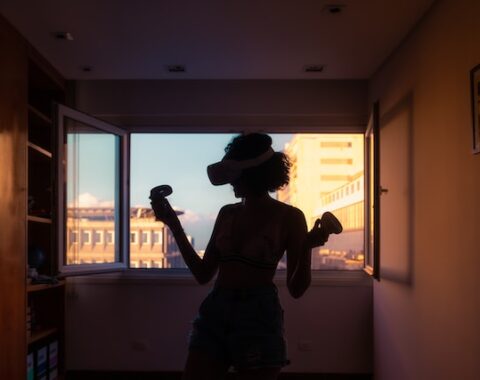Table of Contents:
Both the real world and the virtual world are being occupied by digital clothing. Many companies are using digital clothing to create digital content, fashion design & technology, gaming, and other things.
The metaverse is full of different subcultures and demographics that creatives can use to customize their brands and reach people they might not have reached before. It is a community-based commerce platform for the online world. Brand awareness is brought about by avatars acquiring and changing different skins or items of clothing, which allows brands to avoid the need to actively place product advertisements.
The fashion industry and the Metaverse
The growing number of fashion brands entering the metaverse platform is one of the key factors driving growth in the fashion market. The Metaverse platform can change the way people shop online. Fashion brands, especially clothing brands, rely on attractive labels and branding to sell their products. Launching products online will boost brand recognition and client interaction. The escalating presence of fashion brands on the metaverse will propel the expansion of the market in focus.
What is digital clothing?
Digital clothing is a computer picture created to resemble real-world original apparel. It’s worth mentioning an interesting fact: there are situations where digital clothing cannot be reproduced in the real world. For example, the Adidas Virtual Gear collection. There are no tangible materials in digital clothing. Instead of utilizing fabrics, these garments are fabricated using computer technology and 3D software. The objective of digital fashion designers is to develop, exhibit, and evaluate the attributes of clothing in a virtual environment. Knowledge of materials, manufacturing techniques, ergonomics, and anthropometric measurements is required for digital fashion design, as well as the use of specialized software and equipment.
Blockchain technology has already had a significant impact on numerous aspects of human existence, and this is equally valid for the fashion industry. Since the year 2020, digital fashion has progressed from an unrecognized notion to a rapidly expanding industry. The first Metaverse fashion week took place in March 2022. Some of the most innovative brands are Adidas AG, LVMH, H&M Group, Dolce & Gabbana, and NIKE.
Unlock the future with Mazer: Your innovation partner.
Digital clothing market’s pros and challenges
Privacy and security concerns
Privacy and security concerns regarding the metaverse will pose a significant obstacle for the metaverse in the fashion industry. Even though tech giants are redefining IT security protocols, data protection, and safety remain perennial concerns for those who traverse the virtual realm. There are vast amounts of information about users collected and processed by Metaverse. Therefore, privacy concerns are a major challenge to the global fashion market’s global metaverse. Metaverse possesses the capability to access the personal data of users and may pose a potential threat to their privacy. If hackers get access to a user’s device, their privacy can also be threatened. The way headsets monitor and process the users’ environment is infringing on their privacy and that of those around them.
Environmental friendliness
The ability to experience clothing digitally is more environmentally friendly than the current way of buying clothes. Advertising may also prove to be more environmentally sustainable, as brands collaborate with influencers to promote digital fashion without the necessity of distributing actual products.
Employment opportunities for creative professionals
The enticing propositions could lead to lucrative employment opportunities for graphic designers and 3D artists, who would be required to create digital replicas of actual fashion items and cosmetics. It may also provide an opportunity for designers to work on diverse digital fashion items and enhancements of appearance, such as sunglasses, clothing, jewelry, and other related products. Also, people who make software and computer programs for augmented and virtual reality might get more requests for their services.
Fashion companies have the option to acquire virtual land within the metaverse to establish digital stores that users can interact with through virtual and augmented reality technologies.
Field for experimentation
The metaverse takes away a lot of the friction associated with dressing in what you want to wear or worrying about what people might say. Your online identity becomes more important the more time you spend in this virtual space. There is data that needs to be analyzed to implement new and better designs to meet the demand.
Virtual fitting rooms
A Virtual Try-on (or Virtual Fitting Room) is an innovative digital tool that allows customers to virtually “try on” and test products online, such as clothing, footwear, jewelry, eyewear, or cosmetics. This enables online shoppers to view specific products without leaving their homes, find the right size, and even see how the item looks on them. At Mazer, we have a case study with a virtual try-on for one of the largest brands in Poland.
You may also read: Top 10 Brands in the Metaverse
What is digital clothing?
Digital clothing is computer-generated imagery that resembles real-world clothing but cannot always be replicated physically.
How has blockchain technology impacted the fashion industry and digital clothing market?
Blockchain technology has significantly influenced the fashion industry since 2020, particularly in the metaverse. It has accelerated the growth of digital fashion, with major brands like Adidas AG, LVMH, H&M Group, Dolce & Gabbana, and NIKE embracing innovations like the first Metaverse fashion week in March 2022.
What is a Virtual Try-on?
A Virtual Try-on is a digital tool allowing customers to virtually try on products online, such as clothing, footwear, jewelry, eyewear, or cosmetics. It enables online shoppers to view specific products, find the right size, and see how items look on them personally, enhancing the online shopping experience.
Are you considering implementing innovations or new technologies in your company? Are you interested in using VR, metaverse, or AR?
Unlock the future with Mazer: Your innovation partner.








